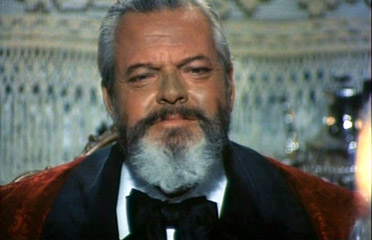 |
Essentially, the film is a four character stage play based upon an Ellery Queen story. Ellery Queen is the pseudonym of two New York authors (Frederic Dannay and Manfred Lee, for you trivia buffs) whose mysteries became the basis of many movies and TV series. Unfortunately, instead of playing out like a mystery, this story unravels as a Greek Tragedy with Orson as Zeus and his "children" taking up various mythological themes. (For example, there is the obvious Oedipus/Electra element, and the symbol of Orson's head on the statue of Jupiter which Norman Bates is carving and eventually destroys.) Ol' Norman acts stranger in this film than in he did Psycho or Crimes of Passion, and he wears one of the strangest wardrobes ever conceived. According to one of Orson's pompous speeches, they all seek to remain permanently frozen in 1928, so Norman runs around in his best Gatsby clothing. More accurately, he dressed as Gatsby would have dressed if he had been a flaming queen. Welles himself wears those same plus-sized bow ties that he would later seem to wear on every talk show in America, as if he truly just stepped out of his Paul Masson commercials. For some inexplicable reason, Welles wore a false nose even though he was, in all other respects, simply just being Orson Welles. I can't fathom why he did that, since it was not very different from his own nose, but the truly uncomfortable part of it is that the nose was green (left)! |
||||
|
Director Claude Chabrol has a great reputation, but whatever talent he had was rarely on display in this film. The atmosphere is drab, the pacing glacial, and a sense of smooth narrative is completely missing. It's such a dull movie that my mind kept wandering, and I had to go back over scenes to pick up on missing details. There are three or four sudden plot twists during the denouement and explanation of the mystery, and that solution was actually fairly clever, but in order to get to that point in the film, you'd really have to want to. What little forward movement the film has is weighted down with the slow pace and gravitas of classical drama, incredibly slow and breathy line recitations by Orson, heavy-handed symbolism, Biblical allusions, and pretentious pseudo-psychology. |
|||||
|
|||||
|
Tuna's notes In the feature length commentary, three film experts go into excruciating detail about shot selection, movie homages, and symbolism, obviously considering this an art film. Frankly, I just saw it as 101 minutes of exposition with no real mystery and a completely predictable outcome. It was filmed without live sound, as is usually the case with Italian films, so the final English dialogue was looped in after the fact, making it sound hollow, and I found the "arty" camera work to be both distracting and too dark. |
|||||
|
|||||
